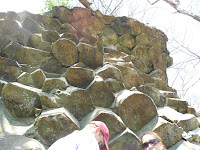There were also two different folitation orientations.
One foliation is to the left of the pen going from upper right to lower left. The other is on the right side of the pen going at a steeper angle.
After Garth Run, we went to the Swift Run formation. The Swift Run formation is between the basement complex granites and the Catoctin flood basalts and was formed from the weathering of the rifted Rodinia. the Swift Run isn't everywhere and where it is located, there are only sections of it. The lithology here is sandstone, metamudstone and conglomerates. In these rocks, we saw primary structures such as graded beds, cross bedding and mud ripup clasts that were parallel to bedding.

 The secondary tectonic structures we saw were folds, and a small s-fold. We measured the fold to be B4 on the Hugleston Diagram.
The secondary tectonic structures we saw were folds, and a small s-fold. We measured the fold to be B4 on the Hugleston Diagram.We measured the bedding and the cleavage and found that the bedding is shallower than the cleavage.
The next day, we went to Skyline Drive in Shenandoah National Park. At one of the overlooks, Sandy Bottom overlook, we found tension gashes and skolithos in the rocks used to build the overlook walls.
After, we made our way to the Limberlost Trail. On this trail, we found columnar jointing. These basalt columns were formed during the breakup of Rodina and the opening of the Iapetus Ocean. Flood basalt flowed into the openings and as it cooled, columns of basalt were left behind. Traditionally, basalt columns have equally spaced centers of contractions and equal angles of about 120 degrees. The ones on the Limberlost Trail were stretched out and the angles were not equal.
 |
| The angles on this 115,120,110,113,75,and 155. |

The next trail stop was a Compton Peak. There, we saw more basalt columns except, instead of looking down at them, we had to look up.
On our way out of Shenandoah National Park, we stopped off at the side of the road to look at a feeder dike. This was one of the many dikes that cut through the rocks and allowed magma to flow to the surface.
Our last stop for the day was a Veach Gap. Veach Gap is in the Massaunutten Synclonorium in the Vally and Ridge province. At Veach Gap, there are 6 anticlines. These anticlines are upright gently plunging , according to the Fleuty or a E4 on the Hudleston diagram.
















